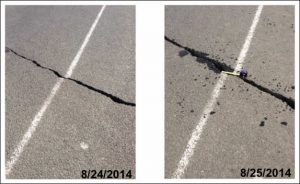
A new study shows that the San Andreas Fault continued to slip gradually for six to twelve years after the 2004 magnitude 6.0 Parkfield, California earthquake, raising the issue of continued damage to structures built across fault zones after damaging earthquakes. This long period of “afterslip” compares to just a year of afterslip for a similar magnitude quake in Napa, California in 2014, demonstrating large variation in fault behavior after earthquakes.
The findings, reported April 18 in the Bulletin of the Seismological Society of America (BSSA), suggest that there can be a range of afterslip durations along faults, making it more challenging to predict how post-earthquake movements might damage nearby infrastructure for years after a major earthquake.
Afterslip refers to the aseismic movement or “creeping” that takes place along a fault, including the trace of its surface rupture, after an earthquake. Some faults have long been known to creep aseismically between earthquakes, such as the part of the San Andreas Fault involved in the Parkfield quake, and these faults are thought to be more prone to afterslip. The fault involved in the Napa earthquake, although not known to be creeping between quakes, exhibited less afterslip.
James Lienkaemper, an emeritus research geophysicist with the U.S. Geological Survey, said the urban Hayward Fault near San Francisco also experiences interseismic creep, and is located in a similar geological setting to the Parkfield fault. He and his colleague Forrest McFarland of San Francisco State University suggest in the BSSA paper that there could be significant afterslip for possibly up to a decade along the Hayward Fault after an expected magnitude 6.8 earthquake there.
Prolonged afterslip could delay post-earthquake recovery by continuing to cause damage to critical infrastructure built across the fault such as rapid transit and utilities, said Lienkaemper, who noted that better forecasts of afterslip “can be used to plan temporary and final repairs to rapid transit tracks, water, gas and data lines.”
“Other major faults of the San Francisco Bay Areas, including Rodgers Creek, Northern Calaveras and Concord-Green Valley, also expect large earthquakes, and should expect significant afterslip, especially in locations where interseismic creep rates are high, and where faults cross deep sedimentary basins,” Lienkaemper added.
Lienkaemper and McFarland found that only about 74 percent of the predicted amount of afterslip for the Parkfield earthquake—a maximum expected value of about 35 centimeters—was complete a year after the earthquake. Their analysis of slip at the six-year mark indicated that afterslip would be completed everywhere on the ruptured fault between six and twelve years after the 2004 earthquake.
The ends of the Parkfield fault were the most likely areas to experience prolonged slipping after the earthquake, Lienkaemper noted, suggesting that slip in these parts of the fault gradually increased as stress transferred from movement of the central section of the rupture.
By contrast, nearly all of the predicted afterslip for the Napa quake was completed a year after the mainshock. After comparing the Parkfield and Napa afterslip with historical afterslip data from around the world, the researchers suggest that there may be a considerable range in the duration of afterslip events. Understanding the susceptibility of a fault to creep, however, could refine estimates of the amount and duration of fault movement during recovery after large earthquakes.
Reference:
“Long-term Afterslip of The M6.0, 2004 Parkfield, California, Earthquake—Implications for Forecasting Amount and Duration of Afterslip on Other Major Creeping Faults,” Bulletin of the Seismological Society of America (2017). DOI: 10.1785/0120160321
Note: The above post is reprinted from materials provided by Seismological Society of America.










